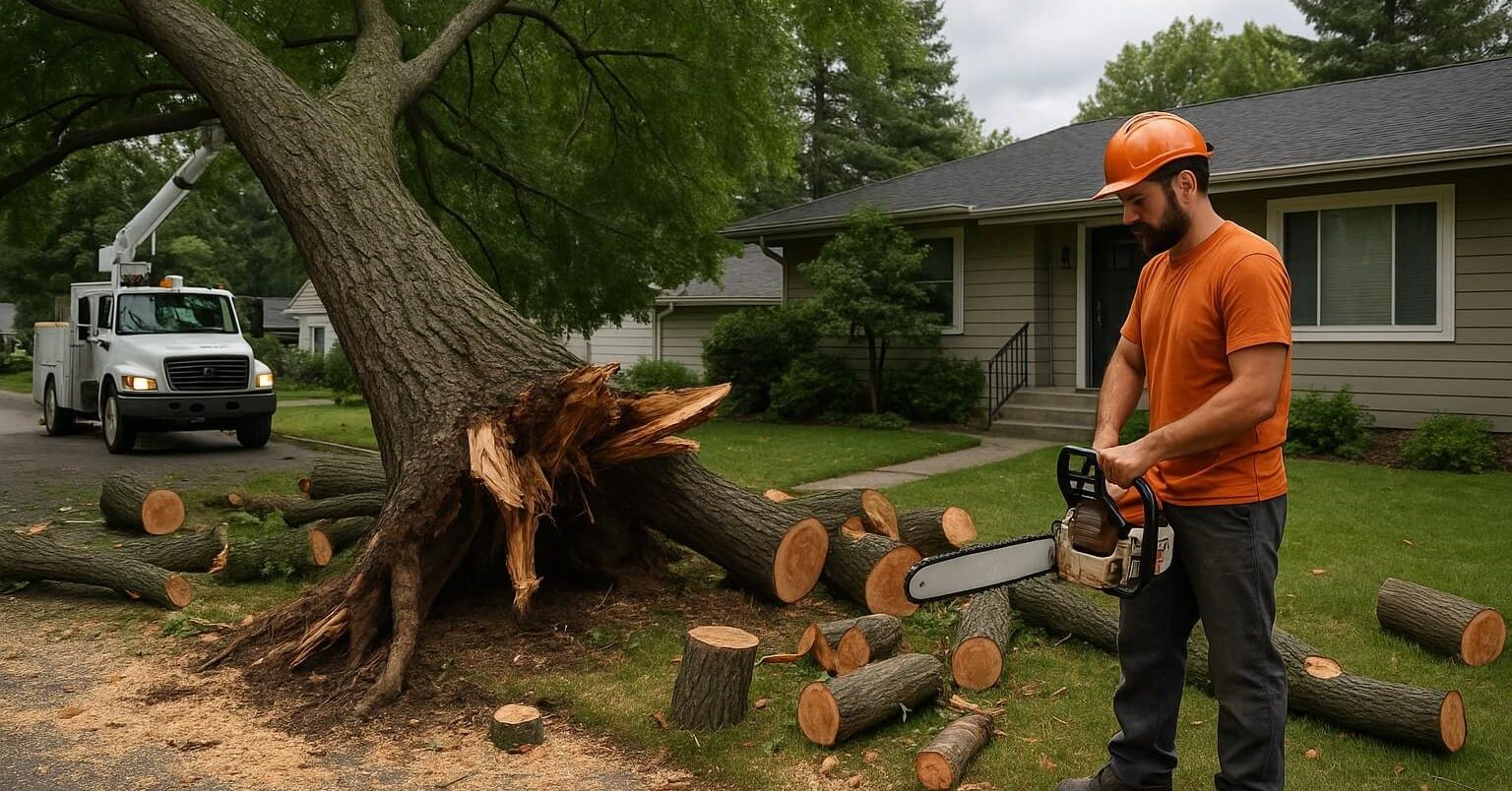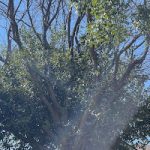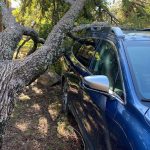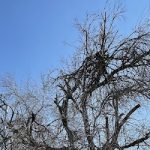
Emergency Tree Service Near Me: What Homeowners Need to Know Before Disaster Strikes
May 7, 2025
North Texas weather can be unpredictable and sometimes destructive. When severe storms roll through Lewisville, they often leave behind damaged or fallen trees that require immediate attention. Understanding what constitutes a true tree emergency, when to call for help, and how to prepare can save you time, money, and potentially prevent further property damage or injury.
Understanding Tree Emergencies in North Texas
Not every fallen branch constitutes an emergency, but certain situations demand immediate professional attention. In Lewisville and surrounding areas, our unique weather patterns and soil conditions create specific challenges when it comes to tree emergencies.
The clay-heavy soils common throughout North Texas create interesting dynamics during severe weather. These soils expand significantly when saturated, which can destabilize even healthy trees during heavy rainfall. This is why you might notice trees leaning dangerously after a major storm, even if they showed no previous signs of instability.
True tree emergencies in North Texas typically include:
- Trees or large limbs that have fallen on structures, vehicles, or across access points
- Trees leaning precariously toward homes or power lines following ground saturation
- Split trunks or major structural damage that poses imminent falling hazards
- Trees or branches entangled with power lines
- Lightning-damaged trees with unstable remaining structures
- Root plate lifting (when the ground rises around the base of a tree) following storms
The spring and early summer months are particularly active for tree emergencies in Lewisville due to our thunderstorm season. These storms often combine high winds, heavy rainfall, and occasionally hail – creating multiple stress factors for trees simultaneously.
Winter presents different challenges, with occasional ice storms adding significant weight to branches. Just one-quarter inch of ice can add hundreds of pounds of weight to a mature tree’s canopy, causing branches to snap and creating widespread emergency situations throughout the region.
How Emergency Tree Services Actually Work
When you’re dealing with a fallen tree or dangerous situation, understanding the process helps set proper expectations during a stressful time. Here’s what typically happens during a tree emergency in Lewisville:
Initial Assessment and Prioritization
When calls come in during or after a major weather event, emergency tree services assess multiple factors to prioritize response:
- Immediate danger to people
- Structural damage where further harm could occur
- Access blockages preventing emergency vehicles or resident access
- Hazards involving utility lines
- Less urgent situations that can be safely addressed later
During major storm events, response times depend greatly on the overall emergency load in the area. Companies typically triage calls based on safety risk rather than first-come, first-served.
On-Site Safety Evaluation
Before any work begins, a professional conducts a site safety assessment that includes:
- Evaluating structural stability of damaged trees
- Identifying hidden hazards like cracked limbs that could fall during work
- Checking for utility line involvement and contacting utility companies if needed
- Determining appropriate equipment needed for safe removal
- Establishing safety perimeters to protect workers and property
The Removal Process
Emergency removal techniques differ significantly from standard tree removal. Emergency situations often require:
- Specialized rigging to remove sections of trees from structures without causing additional damage
- Crane-assisted removal for trees that have fallen on buildings
- Strategic cutting plans that prevent shifting or further property damage
- Temporary stabilization measures when complete removal must wait
Cleanup and Next Steps
After addressing immediate hazards, the process typically includes:
- Removing debris from the property or moving it to accessible locations
- Evaluating remaining trees for hidden damage
- Providing documentation for insurance claims
- Offering recommendations for preventing future emergencies
Critical Safety Considerations During Tree Emergencies
When a tree emergency occurs on your property, safety must be the primary concern. Here are the essential safety considerations every Lewisville homeowner should understand:
Power Line Involvement
The most dangerous tree emergency scenarios involve power lines. If trees or branches are touching power lines:
- Never approach or touch the tree, branch, or power line
- Assume all lines are energized and deadly
- Contact your utility provider immediately (Oncor is the primary electricity provider in Lewisville)
- Keep everyone, including pets, at least 50 feet away
- Do not attempt to move vehicles parked beneath downed lines
Power companies must address the electrical hazards before tree services can safely begin work. This coordination is essential but may extend response times.
Structural Instability Warning Signs
Even if a tree hasn’t completely fallen, certain signs indicate extreme danger and warrant keeping your distance:
- Visible splitting in main trunk
- Leaning trees with soil heaving at the base
- Hanging or partially attached large branches
- Cracking noises coming from the tree
- Fresh cracks or splits that weren’t present before
Indoor Safety During Tree-on-House Scenarios
If a tree has fallen on your home:
- Evacuate anyone from rooms directly affected
- Turn off utilities if you can do so safely
- Avoid the temptation to climb on the roof to assess damage
- Watch for ceiling sagging which may indicate structural compromise
- Consider staying elsewhere until professionals determine the structure is safe
Property Access Considerations
When trees block driveways or access points:
- Ensure you have an alternative emergency exit path from your home
- Do not attempt to drive over or around fallen trees
- Avoid creating makeshift pathways that might be unstable
- Inform emergency tree services if you have medical conditions requiring potential emergency vehicle access
Lewisville Tree Regulations and Emergency Permits
Even during emergencies, certain regulations may apply to tree removal in Lewisville. Understanding these can prevent potential complications or fines.
Emergency Exception Provisions
Lewisville’s tree ordinance includes specific provisions for emergency situations:
- Trees that pose imminent danger to people or property can often be removed without prior permits
- Documentation of the emergency situation should be maintained (photos, professional assessment)
- Post-removal notification to the city may still be required
- Protected tree species may have additional requirements even in emergencies
Historic and Protected Trees
Lewisville has provisions for historically significant and protected trees. Even in emergencies:
- Special considerations apply to trees designated as historic or protected
- Additional documentation may be required
- Replacement requirements often apply even for emergency removals
HOA Considerations
Many Lewisville neighborhoods have Homeowners Associations with their own tree regulations:
- Check your HOA documents for emergency provisions
- When possible, notify your HOA of emergency removals
- Document the emergency nature of the removal for potential HOA review
Post-Emergency Compliance
After emergency removal, certain follow-up steps may be necessary:
- Filing post-removal documentation with the city
- Meeting replacement requirements if applicable
- Obtaining standard permits for any non-emergency work discovered during the emergency response
Common Mistakes Homeowners Make During Tree Emergencies
When facing a tree emergency, stress and urgency can lead to costly mistakes. Being aware of these common pitfalls can help Lewisville homeowners make better decisions during crisis situations.
Attempting DIY Solutions for Complex Situations
One of the most dangerous mistakes is attempting to handle significant tree hazards without professional help:
- Using household ladders near unstable trees
- Operating chainsaws without proper training or safety equipment
- Trying to pull down leaning trees with vehicles
- Climbing onto roofs to cut branches that have fallen on structures
These attempts not only risk personal injury but often create more damage and ultimately cost more than professional services.
Hiring Based on Availability Alone
After major storms, unqualified or uninsured operators often appear offering quick service:
- Always verify insurance and credentials before hiring emergency services
- Request proof of liability insurance and workers’ compensation coverage
- Be wary of door-to-door solicitors without local business verification
Neglecting Insurance Documentation
Many homeowners miss critical steps in documenting tree damage for insurance claims:
- Take comprehensive photos before any work begins
- Document damage from multiple angles
- Keep all estimates, invoices, and professional assessments
- Understand the difference between removal costs (often covered) and preventative measures (sometimes not covered)
Addressing Only Visible Damage
What’s visible after a storm isn’t always the complete picture:
- Adjacent trees may have suffered root damage or structural weakening
- Partially cracked limbs might not be immediately apparent
- Soil saturation effects can appear days after the initial storm
- Root damage might not manifest visible symptoms immediately
A professional assessment of all trees after a significant emergency often prevents secondary emergencies in the coming weeks.
Improper Post-Emergency Treatment
After emergency work, remaining trees often need specific care:
- Avoid immediately fertilizing storm-stressed trees
- Monitor soil moisture levels, especially during post-storm drought periods
- Watch for delayed stress symptoms like leaf wilting or branch dieback
- Consider proper pruning of nearby trees that may have suffered minor damage
Factors That Influence Emergency Tree Service Response
Various factors affect how quickly emergency tree services can respond in Lewisville and what resources they’ll need to deploy. Understanding these factors helps set realistic expectations during crisis situations.
| Factor | Impact on Response | What Homeowners Should Know |
|---|---|---|
| Storm Severity | Widespread events mean longer wait times | Major events may require prioritization based on danger level, not call order |
| Time of Day | Nighttime emergencies may have limited response options | Some work may be delayed until daylight for safety |
| Access Issues | Limited access requires specialized equipment | Trees in backyards or tight areas may need creative solutions |
| Utility Involvement | Power line entanglement requires utility coordination | Utility companies must clear lines before removal can begin |
| Structural Damage | Trees on structures require careful planning | May involve engineering input or controlled dismantling |
| Soil Conditions | Saturated ground affects equipment access | Wet soil can lead to further landscape damage from machinery |
When contacting emergency services, providing clear information about these factors helps companies dispatch appropriate resources on the first visit:
- Precise location of the tree
- Type of structure or property affected
- Whether power lines are involved
- Access limitations (backyard, fence, etc.)
- Size of the tree or affected branches
- Any immediate safety concerns
Frequently Asked Questions About Emergency Tree Services
How Can I Tell If My Situation Is Truly an Emergency?
True tree emergencies involve immediate safety risks or property damage. Situations that qualify include trees or large branches that have fallen on structures, vehicles, or across essential access points; trees leaning toward homes following storms; split trunks threatening imminent falling; and any trees contacting power lines.
Situations that typically don’t qualify as emergencies include small branches down in yards, trees leaning away from structures, or gradually declining trees that show no sudden structural changes.
What Should I Do While Waiting for Emergency Tree Services?
Safety is the priority while waiting for professional help. Establish a safe perimeter around the hazard area, keeping family members and pets away. If the tree has damaged your home, turn off utilities if you can safely do so and consider evacuating if structural integrity is compromised. Document the situation with photos from a safe distance for insurance purposes, but never approach downed power lines or obviously unstable trees.
Will Insurance Cover Emergency Tree Removal?
Most homeowners insurance policies cover tree removal when trees damage insured structures or block driveway access. However, policies vary significantly in their coverage of preventative removals, debris cleanup, or tree replacement. Review your specific policy, document everything with photos, and obtain detailed invoices that clearly separate different services (removal, cleanup, etc.).
How Do Emergency Services Differ from Regular Tree Services?
Emergency tree services involve specialized equipment, techniques, and safety protocols designed specifically for hazardous situations. While regular tree work is typically scheduled days or weeks in advance and follows a standard process, emergency work requires rapid response, crisis assessment skills, and specialized rigging techniques to prevent additional damage. Emergency services also often coordinate with utility companies and municipal emergency services.
What Happens to the Tree Debris After Emergency Removal?
Most emergency services include basic cleanup of major debris, though policies vary by company. During major storm events, some cities in the DFW area provide special curbside pickup for storm debris – Lewisville typically announces these services through city websites and social media after significant weather events. Alternative options include hiring specific debris removal services or renting temporary dumpsters for larger quantities.
How Can I Prevent Future Tree Emergencies?
Prevention starts with regular professional inspection of mature trees, especially those near structures. A licensed tree professional can identify potential weaknesses before they become emergencies. Proper pruning to remove dead wood and reduce wind resistance significantly decreases storm damage risk. Appropriate tree selection for new plantings also matters – native species adapted to North Texas conditions typically withstand our weather extremes better than non-native ornamentals.
Are There Warning Signs I Should Watch For Before a Tree Becomes an Emergency?
Several indicators suggest a tree might become a future emergency: visible cracks in major limbs or trunks; leaning that worsens over time; fungi growing from the base or trunk (indicating decay); significant deadwood throughout the canopy; and soil heaving or cracking around the root zone. Seasonal inspections after major weather events can catch these warning signs before they escalate to emergency situations.
What Questions Should I Ask Before Hiring an Emergency Tree Service?
Always verify insurance coverage (general liability and workers’ compensation), credentials, local experience with Lewisville’s tree species and soil conditions, and emergency-specific equipment availability. Ask about their approach to minimizing additional property damage, coordination with insurance companies, and post-emergency cleanup processes.
When tree emergencies happen in Lewisville, having the right information helps you make sound decisions during stressful situations. While we hope you never experience a tree emergency, being prepared with knowledge about proper procedures, safety considerations, and local regulations can make a significant difference in both safety outcomes and financial impact.
If you’re concerned about potentially hazardous trees on your property, consider scheduling a preventative assessment before the next storm season. Professional evaluation can often identify and address problems before they become middle-of-the-night emergencies.
Emergency Tree Service Available Across North Texas
Quality Tree Service DFW proudly offer 24/7 emergency tree removal and storm response services in the following North Texas communities:
- Emergency Tree Service in Shady Shores, TX
- Emergency Tree Service in Lewisville, TX
- Emergency Tree Service in Flower Mound, TX
- Emergency Tree Service in Denton, TX
- Emergency Tree Service in Southlake, TX
- Emergency Tree Service in Coppell, TX
- Emergency Tree Service in Frisco, TX
- Emergency Tree Service in Grapevine, TX
- Emergency Tree Service in Plano, TX
- Emergency Tree Service in The Colony, TX
- Emergency Tree Service in McKinney, TX
- Emergency Tree Service in Colleyville, TX
No matter where you are in the DFW metro area, our team is ready to respond quickly, assess storm damage, and safely remove hazardous trees-day or night.






